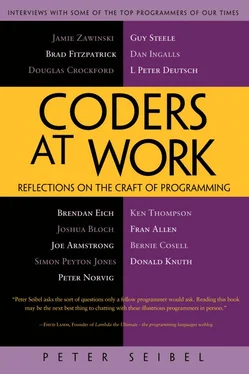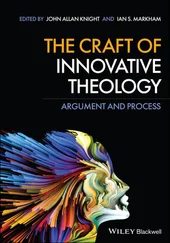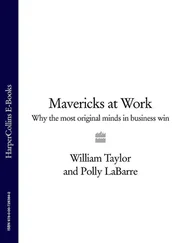Peter Seibel - Coders at Work - Reflections on the craft of programming
Здесь есть возможность читать онлайн «Peter Seibel - Coders at Work - Reflections on the craft of programming» весь текст электронной книги совершенно бесплатно (целиком полную версию без сокращений). В некоторых случаях можно слушать аудио, скачать через торрент в формате fb2 и присутствует краткое содержание. Жанр: Программирование, на английском языке. Описание произведения, (предисловие) а так же отзывы посетителей доступны на портале библиотеки ЛибКат.
- Название:Coders at Work: Reflections on the craft of programming
- Автор:
- Жанр:
- Год:неизвестен
- ISBN:нет данных
- Рейтинг книги:3 / 5. Голосов: 1
-
Избранное:Добавить в избранное
- Отзывы:
-
Ваша оценка:
- 60
- 1
- 2
- 3
- 4
- 5
Coders at Work: Reflections on the craft of programming: краткое содержание, описание и аннотация
Предлагаем к чтению аннотацию, описание, краткое содержание или предисловие (зависит от того, что написал сам автор книги «Coders at Work: Reflections on the craft of programming»). Если вы не нашли необходимую информацию о книге — напишите в комментариях, мы постараемся отыскать её.
Coders at Work
Founders at Work
Coders at Work: Reflections on the craft of programming — читать онлайн бесплатно полную книгу (весь текст) целиком
Ниже представлен текст книги, разбитый по страницам. Система сохранения места последней прочитанной страницы, позволяет с удобством читать онлайн бесплатно книгу «Coders at Work: Reflections on the craft of programming», без необходимости каждый раз заново искать на чём Вы остановились. Поставьте закладку, и сможете в любой момент перейти на страницу, на которой закончили чтение.
Интервал:
Закладка:
So at the center of the BitBlt operation there’s essentially one long shifter, which is picking up words from the source and dropping them in the destination. That was the thing I had to sit down and think about. But once you had that you could do storing of constants this way, you could do the laying down of text, the extraction of glyphs from a font, and putting them down at any pixel location.
Seibel:Back to the BASIC implementation of Smalltalk: that was sort of the primordial Smalltalk, before even Smalltalk-72?
Ingalls:Right. The minute that worked I set off and did this whole assembly-language version—because that’s what I had on the Nova—that was fairly complete. So we used that to debug a bunch of stuff and then, in parallel with that, the Alto was being built. As soon as it was available, we moved over and started running on the Alto. That became Smalltalk-72.
Seibel:So Smalltalk-72 was written in assembler—where along the line did it become self-hosting? You often hear that one of the great things about Smalltalk was that so much of it was implemented in itself.
Ingalls:That was a long time later. Smalltalk-72 had a big pile of assembly code with it. And Smalltalk-76 did, too. The big difference from Smalltalk-72 to Smalltalk-76 was that I came up with the byte-code engine for Smalltalk that had the keyword syntax and it was compilable. Also that classes and even stack frames were real objects, to your point about self-description.
Seibel:Where did you get the idea to write a byte-code interpreter?
Ingalls:That was a mechanism. The big thing that I was grappling with was that Smalltalk-72 parsed on the fly and for two reasons, at least, we needed to be able to compile something that had those kinds of semantics but that didn’t require parsing everything on the fly.
So I came up with the Smalltalk-76 syntax, which is pretty much the Smalltalk-80 syntax. Then the question is, what do you compile that into that will run effectively this way? The only place where it got complicated was in doing what we called remote evaluation—variables you declare up here but they get evaluated down here. This is what ended up as blocks in Smalltalk, which are like closures in other systems.
Seibel:Why not just compile to machine code?
Ingalls:We were still very space-conscious and this stuff wound up incredibly compact compared to anything else around. And it needed to be that compact because we were still trying to run this on Altos that had 96K. Then they came out with the big one, which was 128K. The compactness was important.
Seibel:Meaning the generated code would be smaller because the byte codes were richer than native machine instructions?
Ingalls:Yeah. I also just plain loved the idea and was inspired by Peter Deutsch’s work on the byte-code engine for Lisp. I was further inspired by this synergy—it’s another one of these kernels that could fit in microcode. From the beginning I envisioned it as going into the microcode of the Alto.
Seibel:And the microcode was RAM so you could put the Smalltalk kernel in there and then switch to Lisp and put the Lisp byte-code interpreter in there.
Ingalls:Yup.
Seibel:Then what was the next evolution?
Ingalls:Smalltalk-76 inherited all the same sort of graphics baggage—a lot of special code for line drawing, text display, and so on. But at that time I had done BitBlt, so I rewrote the kernel so all the graphics just used BitBlt and Smalltalk, so that made the kernel much smaller. That was Smalltalk-78, which was the first one we ran on a microprocessor—on an 8086.
But that still wasn’t Smalltalk in Smalltalk. The Smalltalk in Smalltalk wasn’t until Squeak. Smalltalk-80 had a virtual machine spec that was published in the book, but all the implementations were in C or assembly code.
Seibel:What about the compiler?
Ingalls:The compiler was written in Smalltalk. Actually, when we were doing the Smalltalk-80 books, Dave Robson and I—it was mainly his work—wrote a Smalltalk emulation of the byte-code interpreter. As part of the Smalltalk-80 release we wanted to help people build their own virtual machines. We had discovered that one of the most useful aids was a trace of exactly what byte-codes get executed in what order when you first start up the system.
So he wrote an emulator in Smalltalk, because our Smalltalk was getting fast enough that that was a reasonable thing to do, and produced all those traces that would help people debugging.
Seibel:And you wanted to help people write Smalltalk virtual machines because the point of Smalltalk-80 was to be an escape pod so Smalltalk could go out into the world even if PARC decided not to do anything with it?
Ingalls:That’s right. Then I left the industry and when I came back, I wanted to do a Smalltalk for a new project. At that time things were running so fast that, “Wait a minute; why don’t we just try running the Smalltalk version of it and see what that does?” But the “aha!” was, it shouldn’t be hard to mechanically translate that to C and then it would be as fast as the other engines. If you wanted to change something about the virtual machine you could change that in Smalltalk—you could try it out in Smalltalk and then push a button, and it would suddenly be in the production interpreter.
Seibel:So you took this Smalltalk interpreter written in whatever subset of Smalltalk it happened to be written in and wrote a special-purpose compiler that knows how to compile that subset into C?
Ingalls:And the C translator was simply a subset of the Smalltalk compiler—we just had to make the parse trees print out in C. This was actually something we had done before at Xerox—Ted Kaehler had written a virtual memory in Smalltalk, and then we used the same trick to translate that to BCPL. Same thing.
Seibel:When Smalltalk-80 got out in the world there were Smalltalk companies; objects were a big thing; Byte did its issue all about Smalltalk.
The promise was that objects were going to be these reusable components and that programmers would just go down to Ye Olde Object Shoppe and buy some objects and plug them into their program. Has that promise been kept?
Ingalls:I think yes and no.
Seibel:So in what ways has it happened?
Ingalls:Look at the world of Java—it’s that kind of a world. There are huge bodies of software that work well together because of those kinds of interfaces. I think that was all a real step forward. There were several things going on in Smalltalk that did end up in the world more or less. One of them is object-oriented design and interfaces. The other is dynamic languages and user interfaces. It didn’t take over and you can look at various little places in history where things could have been done differently and it might have had a better chance. But I don’t think that’s a big thing lost or gained. The world moves forward slowly. Other things got done that were better. Natural selection takes care of it all.
Seibel:But natural selection can also select some pretty grotesque outcomes.
Ingalls:Oh yeah, Beta and VHS, it’s true. But ultimately, nothing that’s really good ever gets really lost.
Seibel:Another aspect of Smalltalk that Alan Kay has particularly emphasized in recent years is that it wasn’t supposed to be about objects; it was about message passing. C++ and Java don’t have message passing in nearly the same way Smalltalk did. Why is that such a core idea?
Читать дальшеИнтервал:
Закладка:
Похожие книги на «Coders at Work: Reflections on the craft of programming»
Представляем Вашему вниманию похожие книги на «Coders at Work: Reflections on the craft of programming» списком для выбора. Мы отобрали схожую по названию и смыслу литературу в надежде предоставить читателям больше вариантов отыскать новые, интересные, ещё непрочитанные произведения.
Обсуждение, отзывы о книге «Coders at Work: Reflections on the craft of programming» и просто собственные мнения читателей. Оставьте ваши комментарии, напишите, что Вы думаете о произведении, его смысле или главных героях. Укажите что конкретно понравилось, а что нет, и почему Вы так считаете.












